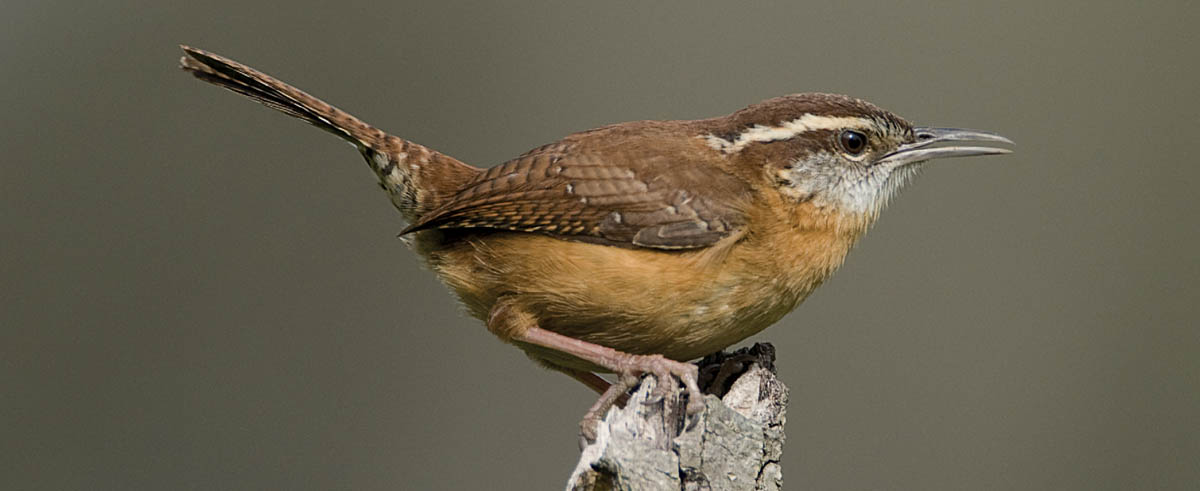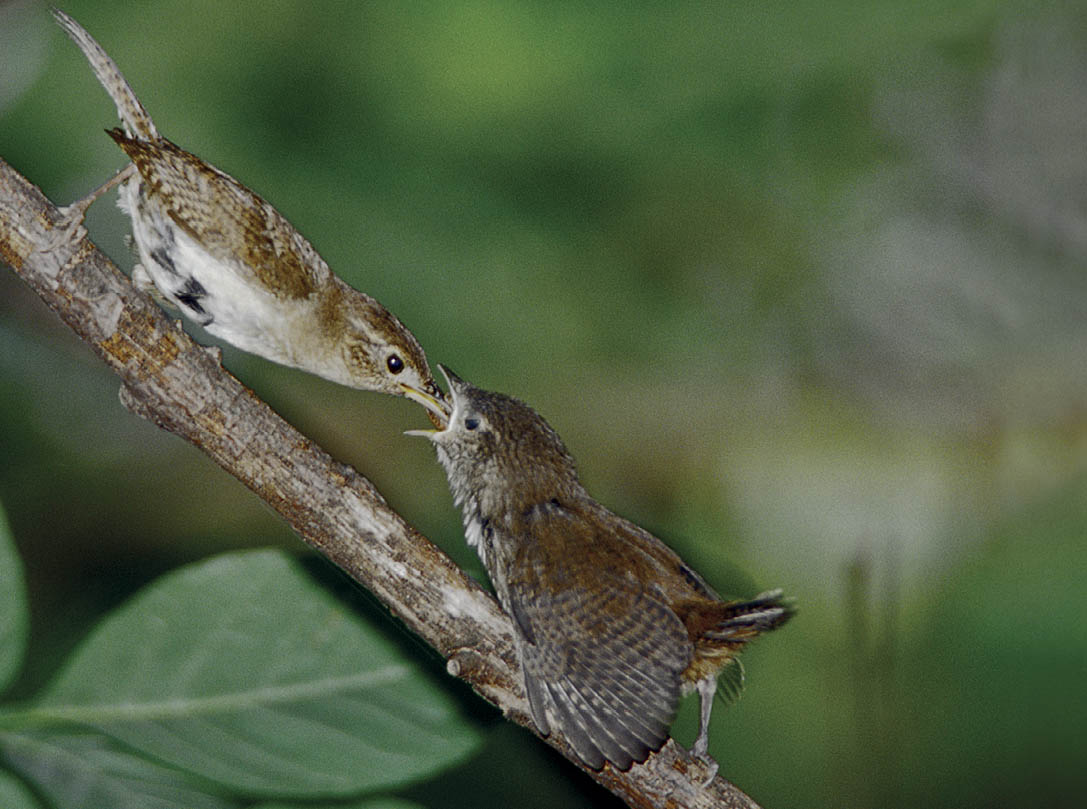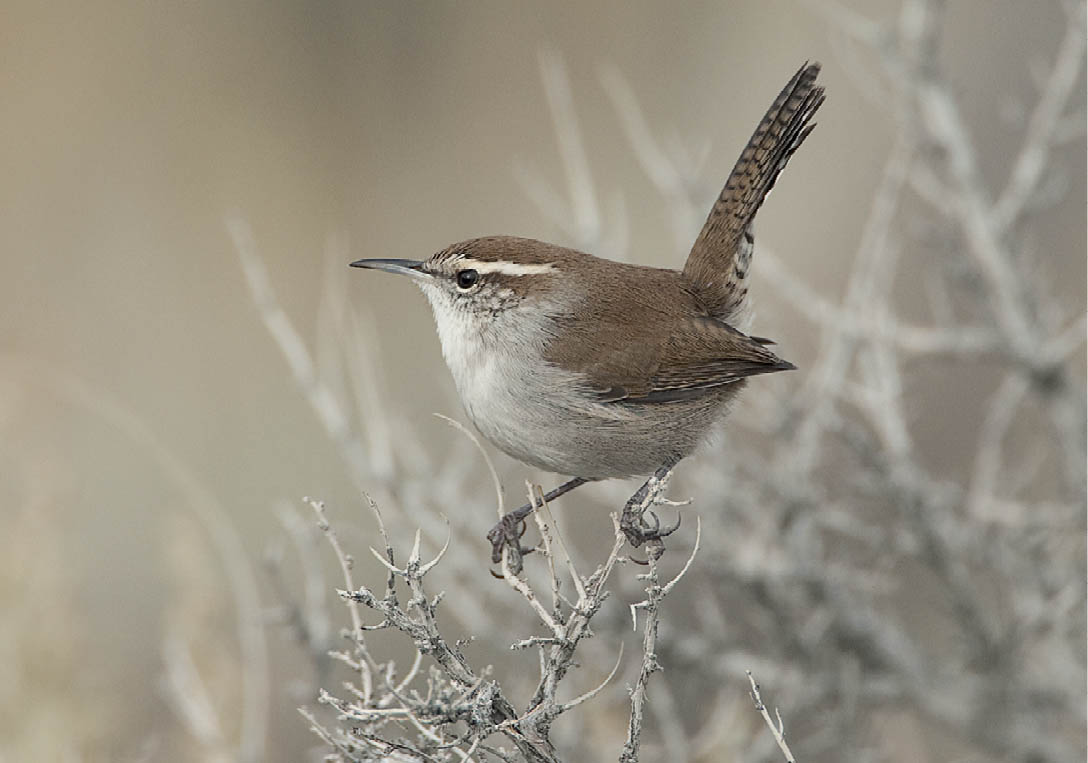
House Wren adult
House Wrens weigh a mere third of an ounce (about 10 grams) — you could mail three with a single stamp. Mortality is so high that even though each pair raises about two fairly large broods each season, few wrens reach their first birthday and populations remain steady. Fortunately, once House Wrens survive their first migrations and first winter, their life expectancy is longer. One bird banded in 1984 in New York was retrapped and released a full nine years later, still healthy.

House Wren adult
In spring, as soon as male House Wrens arrive on territory, they claim every potential nest site they find. These are usually woodpecker holes, other tree cavities, and birdhouses, but can include empty cow skulls, fishing creels, watering pots, tin cans, hats, boots, shoes, the nozzle of a pump, holes in walls, mailboxes, overalls hanging on a clothesline, and even the axle of a car that was driven every day.

A male House Wren brings a stick to the entrance of an old woodpecker cavity in an aspen. As soon as he claims a territory, the male starts filling empty cavities with sticks. The female chooses one cavity for her actual nest.
When a male discovers a possible site, he starts filling it with sticks — often hundreds — building a platform with a depression for the nest cup. He also piles up twigs above the platform that serve as a barrier between the entrance hole and the nest itself.

A House Wren packed this nest box almost to the top with sticks. The actual nest is tucked out of sight in a depression in the back right corner. The sticks often form a barrier between nest and entrance, possibly to protect against cold weather, predators, or cowbirds. The stick platform also raises the nest so its lining stays dry if rainwater leaks in.

A male House Wren displays to his mate (out of sight above him at their nest hole) by quivering his wings and singing excitedly. A similar display occurs during territorial defense against intruding male wrens.
When his loud, persistent singing attracts a female to his territory, he acts like a tiny real estate agent, showing her each of his little properties as a “fixer-upper.” If she chooses one, she immediately gets to work, finishing the platform and nest cup, and then lining the cup with soft materials such as grasses, soft inner bark, and fur or hair, finishing it off with feathers. Sometimes spider egg sacs are included in the nest. The spiderlings from these sacs may consume nest parasites that otherwise could harm the wrens.
She may make 300 or more trips to the nest site during construction before she lays her first egg. She lays one egg per day in early morning.
Steady incubation begins when she has a full clutch of three to ten eggs, and the eggs hatch in the order laid, sometimes all on the same day. Some males may feed females during incubation, but most spend that time singing and staying close to, but not on, the nest when the female needs a break.

A female wren brings a beakful of grass as nest material. After pairing, she finishes off the stick platform and nest cup, which she lines with soft grasses or inner bark, animal hair or fur, and feathers.

This House Wren nest contains seven eggs. House Wrens produce one or two broods per year, often switching mates between broods. The female incubates alone for nine to sixteen days; incubation is shorter later in the season.

Carolina Wrens also nest in boxes. They are non-migratory, and mated pairs remain together year-round. Pairs of many of their tropical relatives sing complex duets, but only the male Carolina Wren sings its loud tea-kettle, tea-kettle, tea-kettle song. Many of their nesting behaviors are similar to those of House Wrens.
About 12 days after the last egg was laid, the first egg hatches and the father House Wren is suddenly very busy. Until the hatchlings can regulate their body temperature, he spends his time searching for food while mom broods the chicks to keep them warm. As they grow, both parents feed them.
Newly hatched. Four House Wren nestlings lie next to an unhatched egg. Altricial, they hatch with eyes closed and mostly naked except for sparse, dark down. The yellow color showing through the skin at their rear ends is the remains of the yolk sac, which nourished them inside the egg.

Half-grown. Begging nestlings show their orange gapes edged with pale yellow flanges. Now half-grown, their eyes are almost fully open, pinfeathers cover their wings, and dark feather tracts show on their heads and along their backs.

15–17 days old. House Wren nestlings near fledging age are packed together in their nest. They are fully feathered although their wings and tails are not yet adult length, and their bills are still edged with swollen pale yellow flanges.

After feeding its young, a House Wren backs out of the nest cavity with a fecal sac that it will deposit on a branch 40 to 100 feet away from the nest. Parents also carry similar-looking spider egg cases into the nest. The spiders may control insect pests.

A House Wren adult feeds its fledgling. Now the chick’s wings are almost adult length, but its tail is still quite short. For nearly two more weeks, the parents will feed it (depending on whether the female has switched mates and/or started a second brood).

When the first-hatched chick is 15 to 17 days old, the chicks fledge, all within just a few hours. Rarely, the smallest isn’t ready to fledge and gets left behind; that one invariably dies because the parents are so focused on keeping track of the others.
Around this time one of the parents (usually the female) may grow restless and be drawn to a new mate’s territory. Back at the nest, the remaining male may start singing to attract a new mate, even while caring for the fledglings. He shows her some of the cavities he’s already filled with sticks. If a female accepts one, she finishes the nest and starts laying eggs while he attends to his previous brood. Switching mates like this allows each individual to maximize the number of chicks raised each year.
House Wrens wearing U.S. Fish and Wildlife Service leg bands have survived more than nine years.
Bewick’s Wren was once the common “house wren” of the Appalachian Mountains and the Midwest. Its disappearance coincided with the range expansion of House Wrens, who puncture the eggs of birds on their territories and may have especially targeted Bewick’s Wrens as competitors for nest sites. Pesticides and competition with introduced House Sparrows and European Starlings also figured in the species’ decline in the East.
Fortunately, Bewick’s Wrens are doing well over most of their range in the West. Non-migratory populations are monogamous over a nesting season and possibly from year to year. Birds of both sexes seldom wander far from their nesting territories at any time of year.
